Understanding Teiid BufferManager
- Tuple, TupleBatch, TupleSource and TupleBuffer
- STree
- BatchManager
- LRFU Eviction Queue
- StorageManager
- BufferManager usage cases
As below figure, the Key Interface of Teiid BufferManager is BufferManager, it extends of interface StorageManager and TupleBufferCache.
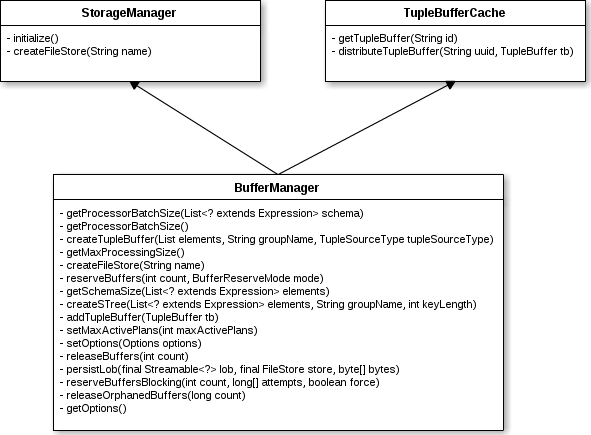
The buffer manager controls how memory is used and how data flows through the system. It uses StorageManager to retrieve data, store data, and transfer data. The buffer manager has algorithms that tell it when and how to store data. The buffer manager should also be aware of memory management issues.
Tuple, TupleBatch, TupleSource and TupleBuffer
-
A
Tuplein Teiid is equivalent to a list data structure,TupleBufferhas the ‘addTuple()’ method, that means add a list data. The data type in list be defined with ElementSymbol list, we will show this in example in example section. -
A
TupleBatchin Teiid is a list ofTuple, it’s structure like
List<List<?>> tuples;
TupleBuffer also has addTupleBatch() method, it used to add a list of Tuple, we will show this in example section.
- A
TupleSourceis a cursored source of tuples. The implementation will likely be closely bound to aBufferManager, below figure showing TupleSource implementation in Teiid:
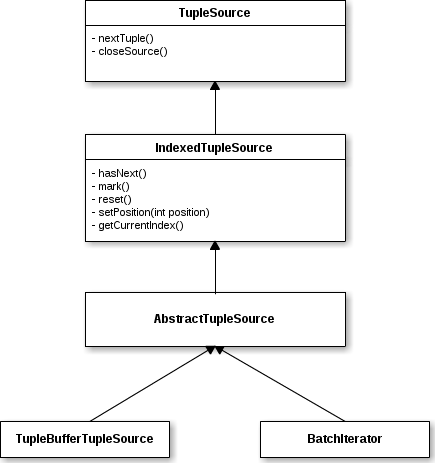
- A
TupleBufferis a interactive interface for BufferManager, as the depiction of BufferManager UML diagram, there are several methods related with TupleBuffer, like
TupleBuffer createTupleBuffer(List elements, String groupName, TupleSourceType tupleSourceType) throws TeiidComponentException;
TupleBuffer getTupleBuffer(String id);
A typical usage of TupleBuffer is like:
- Create TupleBuffer
- Add Tuple or TupleBatch to TupleBuffer
- Create TupleSource via TupleBuffer
- Iterator Tuple data in TupleSource
Example.1 TupleBuffer with Tuple and TupleSource
Assuming PRODUCTView under Test model, the create PRODUCTView SQL like:
CREATE VIEW PRODUCTView (
product_id integer,
symbol string
) AS SELECT p.product_id, p.symbol FROM PRODUCT AS p;
PRODUCTView has 6 rows data as below figure:
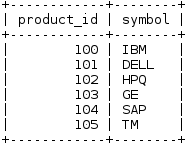
The example below show how use TupleBuffer add Tuple and iterator data via TupleSource.
BufferManager bm = BufferManagerFactory.getStandaloneBufferManager();
List<ElementSymbol> elements = new ArrayList<>();
ElementSymbol id = new ElementSymbol("Test.PRODUCTView.product_id");
id.setType(DataTypeManager.DefaultDataClasses.INTEGER);
ElementSymbol symbol = new ElementSymbol("Test.PRODUCTView.symbol");
symbol.setType(DataTypeManager.DefaultDataClasses.STRING);
elements.add(id);
elements.add(symbol);
TupleBuffer buffer = bm.createTupleBuffer(elements, "ConnectionId", TupleSourceType.PROCESSOR);
buffer.setForwardOnly(false);
buffer.addTuple(Arrays.asList(100, "IBM"));
buffer.addTuple(Arrays.asList(101, "DELL"));
buffer.addTuple(Arrays.asList(102, "HPQ"));
buffer.addTuple(Arrays.asList(103, "GE"));
buffer.addTuple(Arrays.asList(104, "SAP"));
buffer.addTuple(Arrays.asList(105, "TM"));
TupleBufferTupleSource tupleSource = buffer.createIndexedTupleSource();
tupleSource.setReverse(true);
while(tupleSource.hasNext()) {
System.out.println(tupleSource.nextTuple());
}
tupleSource.closeSource();
Run above code will output
[105, TM]
[104, SAP]
[103, GE]
[102, HPQ]
[101, DELL]
[100, IBM]
Example.2 TupleBuffer with TupleBatch and TupleSource
The same as Example.1 TupleBuffer with Tuple and TupleSource scenarios, this example show how use TupleBuffer add TupleBatch and iterator data via TupleSource.
BufferManager bm = BufferManagerFactory.getStandaloneBufferManager();
List<ElementSymbol> elements = new ArrayList<>();
ElementSymbol id = new ElementSymbol("Test.PRODUCTView.product_id");
id.setType(DataTypeManager.DefaultDataClasses.INTEGER);
ElementSymbol symbol = new ElementSymbol("Test.PRODUCTView.symbol");
symbol.setType(DataTypeManager.DefaultDataClasses.STRING);
elements.add(id);
elements.add(symbol);
TupleBuffer buffer = bm.createTupleBuffer(elements, "ConnectionId", TupleSourceType.PROCESSOR);
buffer.setForwardOnly(false);
TupleBatch batch = new TupleBatch(1, Arrays.asList(Arrays.asList(100, "IBM"), Arrays.asList(101, "DELL"), Arrays.asList(102, "HPQ"), Arrays.asList(103, "GE"), Arrays.asList(104, "SAP"), Arrays.asList(105, "TM")));
buffer.addTupleBatch(batch, true);
TupleBufferTupleSource tupleSource = buffer.createIndexedTupleSource();
tupleSource.setReverse(true);
while(tupleSource.hasNext()) {
System.out.println(tupleSource.nextTuple());
}
tupleSource.closeSource();
Run above code will output the same result as Example.1.
Example.3 TupleBatch with Tuple
The same as Example.1 TupleBuffer with Tuple and TupleSource scenarios, This example will create a TupleBatch, set the TupleBatch’s attributes.
TupleBatch batch = new TupleBatch(1, Arrays.asList(Arrays.asList(100, "IBM"), Arrays.asList(101, "DELL"), Arrays.asList(102, "HPQ")));
batch.setTerminationFlag(true);
long sourceRow = 1;
while (true){
if(batch.getRowCount() > 0 && sourceRow <= batch.getEndRow()){
List<?> tuple = batch.getTuple(sourceRow);
sourceRow++ ;
System.out.println(tuple);
}
if(sourceRow > batch.getEndRow()) {
break;
}
}
Run above code will output
[100, IBM]
[101, DELL]
[102, HPQ]
1
3
STree
The STree is a Self balancing Search Tree. More details from STree please refer to Wikipedia.
Example.1 STree with TupleBatch and Tuples
The Data Structure same as Example.1 TupleBuffer with Tuple and TupleSource’s scenarios, this example show how STree insert.
BufferManager bm = BufferManagerFactory.getStandaloneBufferManager();
List<ElementSymbol> columns = new ArrayList<>();
ElementSymbol id = new ElementSymbol("Test.PRODUCTView.product_id");
id.setType(DataTypeManager.DefaultDataClasses.INTEGER);
ElementSymbol symbol = new ElementSymbol("Test.PRODUCTView.symbol");
symbol.setType(DataTypeManager.DefaultDataClasses.STRING);
columns.add(id);
columns.add(symbol);
STree tree = bm.createSTree(columns, "sessionID", 1);
TupleBatch batch = new TupleBatch(1, Arrays.asList(Arrays.asList(100, "IBM"), Arrays.asList(101, "DELL"), Arrays.asList(102, "HPQ")));
batch.setTerminationFlag(true);
long sourceRow = 1;
while (true){
if(batch.getRowCount() > 0 && sourceRow <= batch.getEndRow()){
List<?> tuple = batch.getTuple(sourceRow);
sourceRow++ ;
tree.insert(tuple, InsertMode.NEW, -1);
}
if(sourceRow > batch.getEndRow()) {
break;
}
}
tree.setBatchInsert(false);
tree.compact();
System.out.println(tree.getRowCount());
Run above code will output
3
BatchManager
BatchManager acts as a combination serializer/cachemanager. It also related with a TupleBuffer.
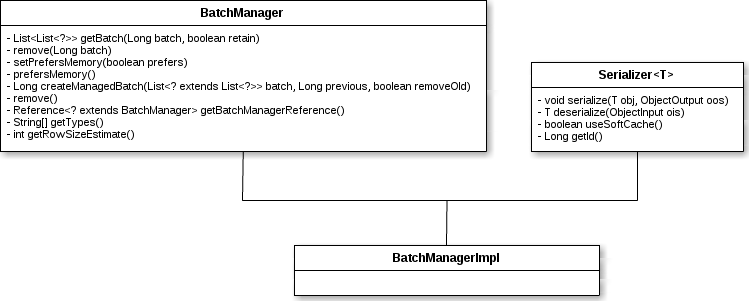
LRFU Eviction Queue
Teiid BufferManager use LRFU Eviction Queue in Cache Eviction, which LRFU means Least Recently Used (LRU) and Least-Frequently Used (LFU), both of them are common Cache algorithms, more details from Wikipedia.
An usage example of LRFU Eviction Queue:
LrfuEvictionQueue<CacheEntry> queue = new LrfuEvictionQueue<CacheEntry>(new AtomicLong());
queue.add(new CacheEntry(1000L));
queue.touch(new CacheEntry(1000L));
queue.remove(new CacheEntry(1000L));
StorageManager
Excepting BufferManager implementing StorageManager, there are some others implemeentation:
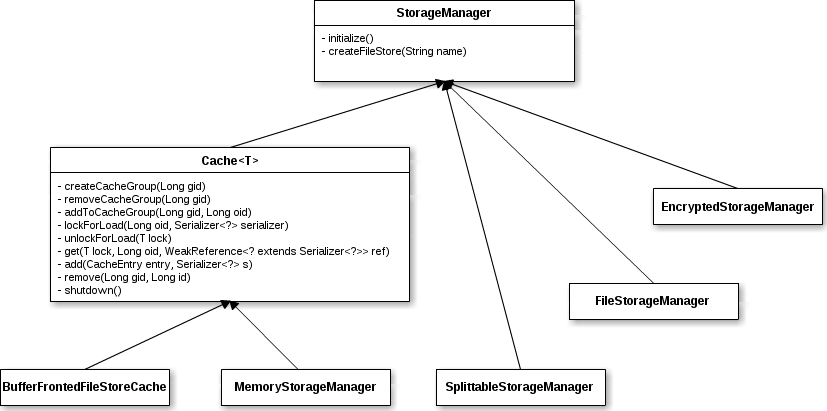
From left to right:
- BufferFrontedFileStoreCache - Implements storage against a FileStore abstraction using a fronting memory buffer with a filesystem paradigm. All objects must go through the memory (typically off-heap) buffer so that they can be put into their appropriately sized storage bucket.
- MemoryStorageManager
- SplittableStorageManager - A storage manager that combines smaller files into a larger logical file. The buffer methods assume that buffers cannot go beyond single file boundaries.
- FileStorageManager - Implements file storage that automatically splits large files and limits the number of open files.
- EncryptedStorageManager - Implements a block AES cipher over a regular filestore.
Corresponding to above 5 StorageManager implementation, StorageManager interface also have a createFileStore() method which return a FileStore, there also are FileStore implementation as below:

NOTE: BufferManager’s default implementation use SplittableFileStore.
BufferManager usage cases
BufferManager be used in DQPCore as below:
- org.teiid.dqp.internal.process.Request’s initialize
public ResultsFuture<ResultsMessage> executeRequest(long reqID,RequestMessage requestMsg) throws TeiidProcessingException{
Request request = null;
...
request.initialize(requestMsg, bufferManager,dataTierMgr, transactionService, state.sessionTables, workContext, this.prepPlanCache);
}
- org.teiid.dqp.internal.process.DataTierManagerImpl’s constructor
public void start(DQPConfiguration theConfig){
...
DataTierManagerImpl processorDataManager = new DataTierManagerImpl(this, this.bufferManager, this.config.isDetectingChangeEvents());
...
}
- org.teiid.query.tempdata.TempTableDataManager’s constructor
public void start(DQPConfiguration theConfig){
...
dataTierMgr = new TempTableDataManager(processorDataManager, this.bufferManager, this.rsCache);
...
}